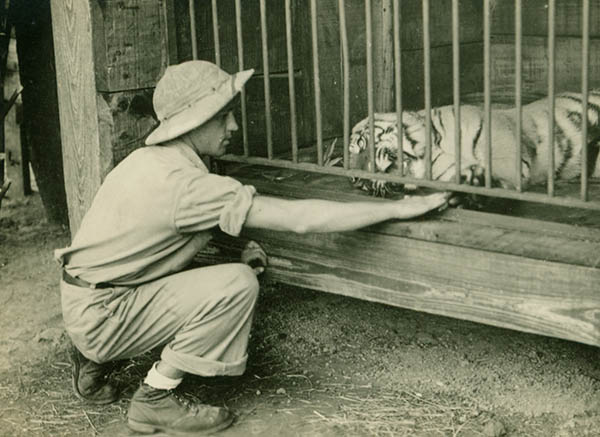Everett Besch: Just before we started today I mentioned that the mascot for the university, the tiger, came out of the Civil War brigades, Louisiana brigades, which were called the Louisiana Tigers. And that the first live mascot was in 1924, but the first tiger, I guess of the series that we have now was what, 1936?
Richard: [agrees]
Besch: Did you say the students bought him?
Richard: Yeah.
Quinn Coco: Contributed a dime apiece.
Besch: It did say student contributions purchased a Bengal tiger named Sheik in 1936. The students contributed a dime a piece?
Richard: [agrees]
Besch: Nineteen thirty-six, they must have had what, how many students on campus?
Coco: About five-thousand, I would guess. Five-thousand students, wasn’t that Oscar?
Richard: Yeah, about.
Besch: And that tiger was renamed for the football trainer named Mike Chambers.
Richard: Yeah.
Besch: What about Mike Chambers? Both of you apparently knew Mike Chambers.
Richard: Well, he was a big guy. He had been . . . I think he was from the University of Illinois. I think he had played football with [Harold E.] “Red” Grange? Isn’t that right?
Coco: [agrees] I think so.
Richard: And he was a trainer for the U.S. Olympic team in 1932. And I think he came to LSU probably in ‘34. I think [Coach Lawrence] “Biff” Jones brought him down. When Biff Jones became head coach, he brought him in as his trainer. Yeah, he was . . . He was pretty popular. And I think it was his idea to get a live mascot. Yeah. He instigated it.
Coco: Tulane Students stole the tiger one time, too, before a Tulane game. When was that Oscar?
Richard: I don’t remember.
Besch: Stole?
Coco: They stole it, yeah.
Besch: A big, a big tiger.
Coco: Yeah, in his cage.
Richard: Yeah.
Besch: Oh, in his cage. Well, I recall in the late seventies when about two o’clock in the morning Campus Police called and said, "You know that Tiger is walking down Nicholson Drive." And . . . actually, they said . . . no . . . “We got the . . . caught the tiger walking down Nicholson Drive.” And the fellow that . . . the cop is still on campus who did . . . who picked up the tiger. And he gradually got ahead of the tiger and just eased him and the tiger kind of turned and walked back. And another cop opened the gate to Bernie Moore Stadium and tiger when in there because there was bushes in there. And we called Bivin, Dr. Sheldon Bivin, who was our laboratory animal veterinarian. And he went out there with a capture gun, and he walked into Bernie Moore Stadium with that damn gun and darted that tiger and that’s how he got him back in the cage. But somebody had cut through the bolts and opened the doors.
-- Oscar Richard, interviewed by Everett Besch and Quinn Coco, 1993

